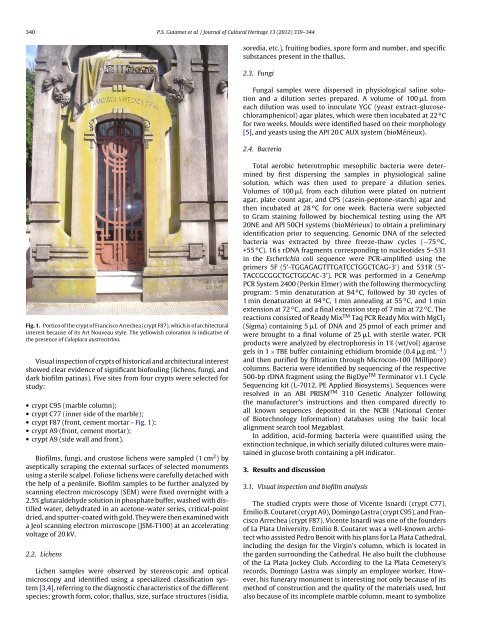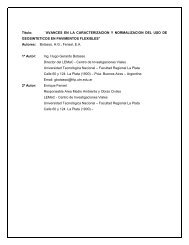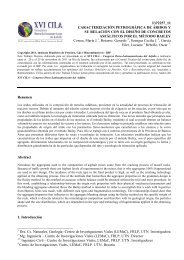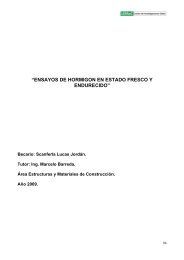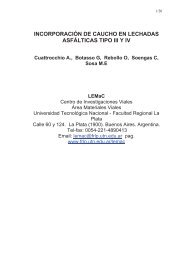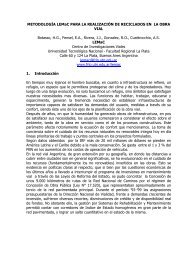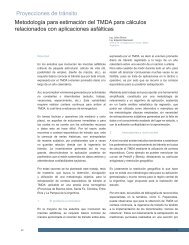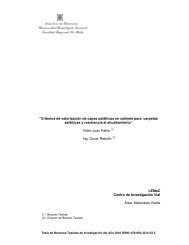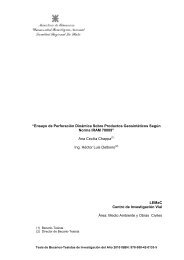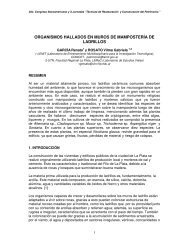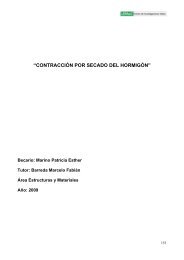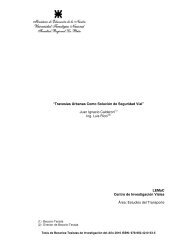Biofouling of crypts of historical and architectural interest at La Plata ...
Biofouling of crypts of historical and architectural interest at La Plata ...
Biofouling of crypts of historical and architectural interest at La Plata ...
Create successful ePaper yourself
Turn your PDF publications into a flip-book with our unique Google optimized e-Paper software.
340 P.S. Guiamet et al. / Journal <strong>of</strong> Cultural Heritage 13 (2012) 339–344<br />
Fig. 1. Portico <strong>of</strong> the crypt <strong>of</strong> Francisco Arrechea (crypt F87), which is <strong>of</strong> <strong>architectural</strong><br />
<strong>interest</strong> because <strong>of</strong> its Art Nouveau style. The yellowish color<strong>at</strong>ion is indic<strong>at</strong>ive <strong>of</strong><br />
the presence <strong>of</strong> Caloplaca austrocitrina.<br />
Visual inspection <strong>of</strong> <strong>crypts</strong> <strong>of</strong> <strong>historical</strong> <strong>and</strong> <strong>architectural</strong> <strong>interest</strong><br />
showed clear evidence <strong>of</strong> significant bi<strong>of</strong>ouling (lichens, fungi, <strong>and</strong><br />
dark bi<strong>of</strong>ilm p<strong>at</strong>inas). Five sites from four <strong>crypts</strong> were selected for<br />
study:<br />
• crypt C95 (marble column);<br />
• crypt C77 (inner side <strong>of</strong> the marble);<br />
• crypt F87 (front, cement mortar – Fig. 1);<br />
• crypt A9 (front, cement mortar);<br />
• crypt A9 (side wall <strong>and</strong> front).<br />
Bi<strong>of</strong>ilms, fungi, <strong>and</strong> crustose lichens were sampled (1 cm 2 ) by<br />
aseptically scraping the external surfaces <strong>of</strong> selected monuments<br />
using a sterile scalpel. Foliose lichens were carefully detached with<br />
the help <strong>of</strong> a penknife. Bi<strong>of</strong>ilm samples to be further analyzed by<br />
scanning electron microscopy (SEM) were fixed overnight with a<br />
2.5% glutaraldehyde solution in phosph<strong>at</strong>e buffer, washed with distilled<br />
w<strong>at</strong>er, dehydr<strong>at</strong>ed in an acetone-w<strong>at</strong>er series, critical-point<br />
dried, <strong>and</strong> sputter-co<strong>at</strong>ed with gold. They were then examined with<br />
a Jeol scanning electron microscope (JSM-T100) <strong>at</strong> an acceler<strong>at</strong>ing<br />
voltage <strong>of</strong> 20 kV.<br />
2.2. Lichens<br />
Lichen samples were observed by stereoscopic <strong>and</strong> optical<br />
microscopy <strong>and</strong> identified using a specialized classific<strong>at</strong>ion system<br />
[3,4], referring to the diagnostic characteristics <strong>of</strong> the different<br />
species; growth form, color, thallus, size, surface structures (isidia,<br />
soredia, etc.), fruiting bodies, spore form <strong>and</strong> number, <strong>and</strong> specific<br />
substances present in the thallus.<br />
2.3. Fungi<br />
Fungal samples were dispersed in physiological saline solution<br />
<strong>and</strong> a dilution series prepared. A volume <strong>of</strong> 100 �L from<br />
each dilution was used to inocul<strong>at</strong>e YGC (yeast extract-glucosechloramphenicol)<br />
agar pl<strong>at</strong>es, which were then incub<strong>at</strong>ed <strong>at</strong> 22 o C<br />
for two weeks. Moulds were identified based on their morphology<br />
[5], <strong>and</strong> yeasts using the API 20 C AUX system (bioMérieux).<br />
2.4. Bacteria<br />
Total aerobic heterotrophic mesophilic bacteria were determined<br />
by first dispersing the samples in physiological saline<br />
solution, which was then used to prepare a dilution series.<br />
Volumes <strong>of</strong> 100 �L from each dilution were pl<strong>at</strong>ed on nutrient<br />
agar, pl<strong>at</strong>e count agar, <strong>and</strong> CPS (casein-peptone-starch) agar <strong>and</strong><br />
then incub<strong>at</strong>ed <strong>at</strong> 28 o C for one week. Bacteria were subjected<br />
to Gram staining followed by biochemical testing using the API<br />
20NE <strong>and</strong> API 50CH systems (bioMérieux) to obtain a preliminary<br />
identific<strong>at</strong>ion prior to sequencing. Genomic DNA <strong>of</strong> the selected<br />
bacteria was extracted by three freeze-thaw cycles (−75 o C,<br />
+55 o C). 16 s rDNA fragments corresponding to nucleotides 5–531<br />
in the Escherichia coli sequence were PCR-amplified using the<br />
primers 5F (5’-TGGAGAGTTTGATCCTGGCTCAG-3’) <strong>and</strong> 531R (5’-<br />
TACCGCGGCTGCTGGCAC-3’). PCR was performed in a GeneAmp<br />
PCR System 2400 (Perkin Elmer) with the following thermocycling<br />
program: 5 min den<strong>at</strong>ur<strong>at</strong>ion <strong>at</strong> 94 o C, followed by 30 cycles <strong>of</strong><br />
1 min den<strong>at</strong>ur<strong>at</strong>ion <strong>at</strong> 94 o C, 1 min annealing <strong>at</strong> 55 o C, <strong>and</strong> 1 min<br />
extension <strong>at</strong> 72 o C, <strong>and</strong> a final extension step <strong>of</strong> 7 min <strong>at</strong> 72 o C. The<br />
reactions consisted <strong>of</strong> Ready Mix TM Taq PCR Ready Mix with MgCl 2<br />
(Sigma) containing 5 �L <strong>of</strong> DNA <strong>and</strong> 25 pmol <strong>of</strong> each primer <strong>and</strong><br />
were brought to a final volume <strong>of</strong> 25 �L with sterile w<strong>at</strong>er. PCR<br />
products were analyzed by electrophoresis in 1% (wt/vol) agarose<br />
gels in 1 × TBE buffer containing ethidium bromide (0.4 �g·mL −1 )<br />
<strong>and</strong> then purified by filtr<strong>at</strong>ion through Microcon-100 (Millipore)<br />
columns. Bacteria were identified by sequencing <strong>of</strong> the respective<br />
500-bp rDNA fragment using the BigDye TM Termin<strong>at</strong>or v1.1 Cycle<br />
Sequencing kit (L-7012, PE Applied Biosystems). Sequences were<br />
resolved in an ABI PRISM TM 310 Genetic Analyzer following<br />
the manufacturer’s instructions <strong>and</strong> then compared directly to<br />
all known sequences deposited in the NCBI (N<strong>at</strong>ional Center<br />
<strong>of</strong> Biotechnology Inform<strong>at</strong>ion) d<strong>at</strong>abases using the basic local<br />
alignment search tool Megablast.<br />
In addition, acid-forming bacteria were quantified using the<br />
extinction technique, in which serially diluted cultures were maintained<br />
in glucose broth containing a pH indic<strong>at</strong>or.<br />
3. Results <strong>and</strong> discussion<br />
3.1. Visual inspection <strong>and</strong> bi<strong>of</strong>ilm analysis<br />
The studied <strong>crypts</strong> were those <strong>of</strong> Vicente Isnardi (crypt C77),<br />
Emilio B. Coutaret (crypt A9), Domingo <strong>La</strong>stra (crypt C95), <strong>and</strong> Francisco<br />
Arrechea (crypt F87). Vicente Isnardi was one <strong>of</strong> the founders<br />
<strong>of</strong> <strong>La</strong> Pl<strong>at</strong>a University. Emilio B. Coutaret was a well-known architect<br />
who assisted Pedro Benoit with his plans for <strong>La</strong> Pl<strong>at</strong>a C<strong>at</strong>hedral,<br />
including the design for the Virgin’s column, which is loc<strong>at</strong>ed in<br />
the garden surrounding the C<strong>at</strong>hedral. He also built the clubhouse<br />
<strong>of</strong> the <strong>La</strong> Pl<strong>at</strong>a Jockey Club. According to the <strong>La</strong> Pl<strong>at</strong>a Cemetery’s<br />
records, Domingo <strong>La</strong>stra was simply an employee worker. However,<br />
his funerary monument is <strong>interest</strong>ing not only because <strong>of</strong> its<br />
method <strong>of</strong> construction <strong>and</strong> the quality <strong>of</strong> the m<strong>at</strong>erials used, but<br />
also because <strong>of</strong> its incomplete marble column, meant to symbolize


